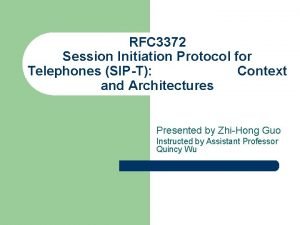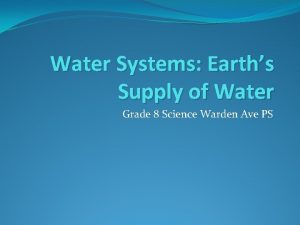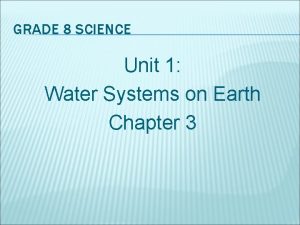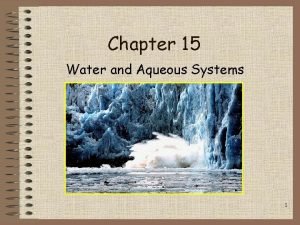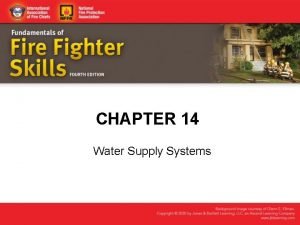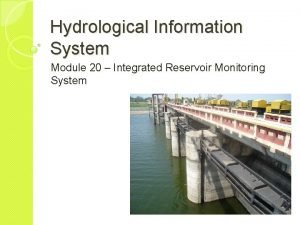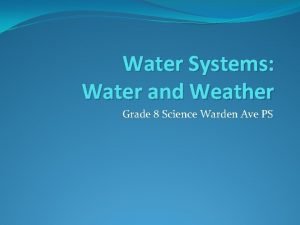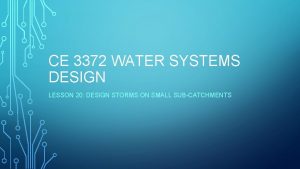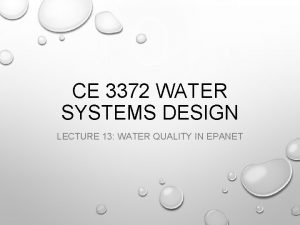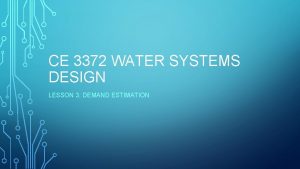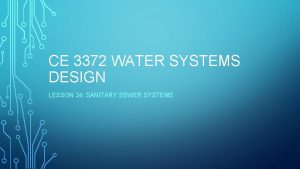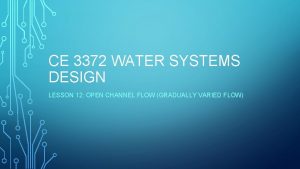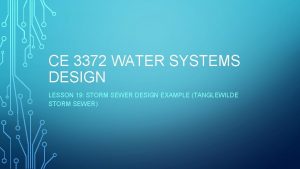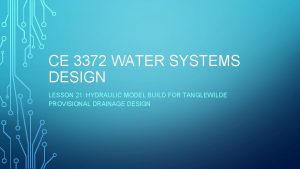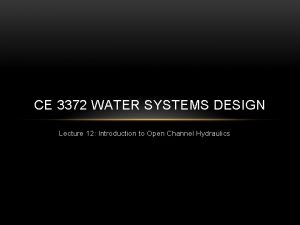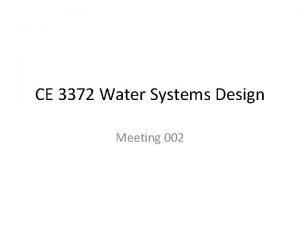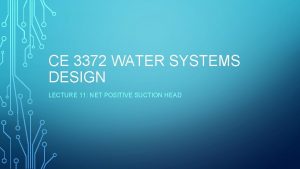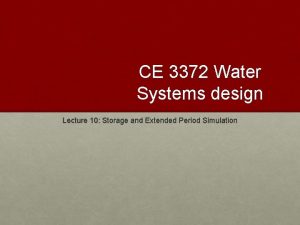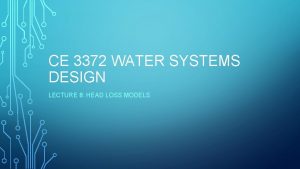CE 3372 WATER SYSTEMS DESIGN LESSON 18 INTRODUCTION
















- Slides: 16

CE 3372 WATER SYSTEMS DESIGN LESSON 18: INTRODUCTION TO SWMM FALL 2020

SWMM • Storm Water Management Model • Originally by University of Florida in the 1970’s • V 1 -4 are FORTRAN • V 5 re-factored into C++ • The computation engine is mature • MIKE URBAN • SOBEK • XP-SWMM • Civil Storm

SWMM • Started as a simplified hydraulic model, evolved into an integrated hydrology-hydraulics model • Pretty useful in urban settings • Used for BMP performance estimation • Used for LID performance estimation

DOWNLOAD AND INSTALL • Google “EPA-SWMM” to find the software • Download the self-extracting archive • Download the user manual

TOUR OF THE INTERFACE • Nodes and Links • Outfall • Sub-catchments and Rain gages • Date/Time • Hydraulics • Hydrology

NODES • Junction Nodes • Storage Nodes • • Invert Elevations Flooding

JUNCTION (NODE) • Ordinary junction connects hydraulic elements (links) • Junction attributes are: • • Invert elevation (elevation of the bottom of the node) Max elevation (elevation of top of node) • • Set to land surface to plot profile grade line in SWMM Set to land surface + added depth for dual (surface+subsurface drainage) • When program runs, depth at the node is computed, but there is no storage (node has zero area)

JUNCTION (NODE) • Ordinary junction just connects pipes N-1, N, and N+1

JUNCTION (NODE) • If flooding occurs, it is only considered when HGL is above node Max. Depth Node not flooded; pipes are surcharged Node flooded; pipes are surcharged

JUNCTION (NODE) • Flooded node attributes: • How deep is the flooding allowed (surcharge depth) above the top of the node • What is the ponded area during surcharge – treats the node as a vertical wall storage tank Ponded Area Ponded Depth Invert Elevation + Max. Depth Invert Elevation

EXAMPLE 1 : RECTANGULAR CHANNEL • Steady flow over a weir; depth at the weir is 2. 0 meters. Determine the water surface profile for a distance 2000 meters upstream using SWMM. Sketch: • Hydraulic Data: • • • Rectangular B = 1 m Steady flow Q = 2. 5 CMS So = 0. 001 n = 0. 025 Dx = 200 meters Outfall boundary == fixed

EXAMPLE 2 : FLOW IN A SEWER • Discharge in a 3 mile long, 60 -inch RCP sewer is 50 MGD. What is the flow depth if the entire sewer is on a 0. 1% slope and the downstream boundary (outfall) is a normal depth condition? • Hydraulic Data: • • • Circular: 60 -inches (5 feet) Steady flow Q = 50 million gallons per day (MGD) So = 0. 001 n = 0. 015 Dx = 2640 feet (use 6 links) Outfall boundary == normal

DESIGN STORM SEWER FOR GOODWIN STREET • “Rational Method Storm Sewer Design” in Mays, L. W. (2008) Water Resources Engineering. Pearson-Prentice Hall (pp. 613635) • Method: Rational Equation Design Method to make initial design for subsequent hydraulics analysis

PREPARATION STEPS • Identify the individual drainage areas. • Determine the area of each contributing area, in acres. (ENGAUGE, PLANIMETER, etc) • Determine the rational runoff coefficient for each area (TABLE LOOKUP)

GATHER THE INFORMATION INTO A SPREADSHEET • Build a sheet with the information • Note the naming convention (a bit awkward, but faithful to the original example)

ESTIMATE PIPE SLOPES • Use the node elevations and topographic map to estimate pipe slopes • Populate the spreadsheet
 Proxyvo
Proxyvo Water and water and water water
Water and water and water water Levels of ecological organization
Levels of ecological organization Introduction of system analysis and design
Introduction of system analysis and design Decision support systems and intelligent systems
Decision support systems and intelligent systems Engineering elegant systems: theory of systems engineering
Engineering elegant systems: theory of systems engineering Embedded systems vs cyber physical systems
Embedded systems vs cyber physical systems Engineering elegant systems: theory of systems engineering
Engineering elegant systems: theory of systems engineering Water systems grade 8
Water systems grade 8 Bartling energy systems recently reported
Bartling energy systems recently reported Grade 8 water systems test
Grade 8 water systems test Water and aqueous systems worksheet answers
Water and aqueous systems worksheet answers Water and aqueous systems chapter 15 answers
Water and aqueous systems chapter 15 answers Chapter 14 water supply systems
Chapter 14 water supply systems Homogeneous aqueous systems
Homogeneous aqueous systems Reservoir monitoring system
Reservoir monitoring system Grade 8 science water systems
Grade 8 science water systems
